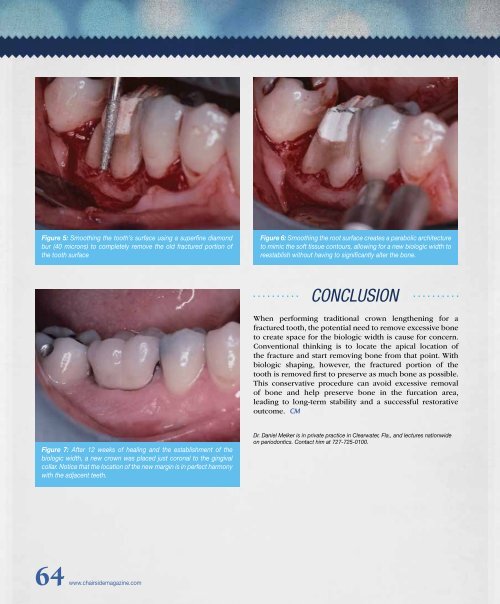Chairside - Glidewell Dental Labs
Chairside - Glidewell Dental Labs
Chairside - Glidewell Dental Labs
Create successful ePaper yourself
Turn your PDF publications into a flip-book with our unique Google optimized e-Paper software.
Figure 5: Smoothing the tooth’s surface using a superfine diamond<br />
bur (40 microns) to completely remove the old fractured portion of<br />
the tooth surface<br />
Figure 6: Smoothing the root surface creates a parabolic architecture<br />
to mimic the soft tissue contours, allowing for a new biologic width to<br />
reestablish without having to significantly alter the bone.<br />
CONCLUSION<br />
When performing traditional crown lengthening for a<br />
fractured tooth, the potential need to remove excessive bone<br />
to create space for the biologic width is cause for concern.<br />
Conventional thinking is to locate the apical location of<br />
the fracture and start removing bone from that point. With<br />
biologic shaping, however, the fractured portion of the<br />
tooth is removed first to preserve as much bone as possible.<br />
This conservative procedure can avoid excessive removal<br />
of bone and help preserve bone in the furcation area,<br />
leading to long-term stability and a successful restorative<br />
outcome. CM<br />
Figure 7: After 12 weeks of healing and the establishment of the<br />
biologic width, a new crown was placed just coronal to the gingival<br />
collar. Notice that the location of the new margin is in perfect harmony<br />
with the adjacent teeth.<br />
Dr. Daniel Melker is in private practice in Clearwater, Fla., and lectures nationwide<br />
on periodontics. Contact him at 727-725-0100.<br />
64 www.chairsidemagazine.com
















